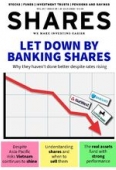Archived article
Please note that tax, investment, pension and ISA rules can change and the information and any views contained in this article may now be inaccurate.
Explaining the basics around shares and how they can make you money

What are shares, why do they exist, what rights do their holders enjoy and how can you make money from owning them?
In this article we will answer these questions and help give you an introduction or refresher on the basics of share ownership.
When companies list on a stock market they divide their capital into shares with each share representing a percentage ownership of the company.
The primary function of the stock market is to raise capital for growth. It also provides an opportunity for owners should they wish to convert some of their ‘paper’ wealth into cash.
The main reason for owning shares is to participate in growth and hopefully get rewarded in time through a rising share price (capital gain) and dividends (income).
ONE SHARE ONE VOTE
Owning more shares increases an investor’s economic interest in a company as well as providing bigger voting power. For example, investor John owns 100 shares of a company which has 100,000 shares outstanding.
John owns an economic interest of 0.1% in the company (100 divided 100,000).
In most companies one share represents one vote at shareholder meetings. This means John would have 0.1% voting power.
But there are other classes of share which have restricted rights or no voting rights as well as classes which convey additional rights. These structures are also referred to as dual-class structures.
Dual-class structures are more common in the US. They appear in large technology firms like Meta Platforms (META:NASDAQ), better known as Facebook and Alphabet (GOOG:NASDAQ), better known as Google.
Meta’s ‘B’ shares give holders 10 votes rather than one which allows founder Mark Zuckerberg to control the company since he controls around 90% of the B shares.
In the UK the stock exchange Listing Rules were amended in 2021 to allow dual-class structures. The idea was, in part, to encourage entrepreneurs to list in London.
The critical difference between UK and US dual-class structures is that in the UK founders are not allowed to use their extra voting rights to determine the composition of the board.
The rules apply to companies listed on the premium segment of the London Stock Exchange. This has higher governance standards compared with a standard listing.
Recent newbies to the stock market Deliveroo (ROO) and Wise (WISE), are both listed on the standard segment and have elected to adopt US-style dual-class structures.
Deliveroo has said it will move to a single class of share after three years on the stock market. It listed in March 2021.
KNOW YOUR RIGHTS
Shareholders can attend annual general meetings and extraordinary meetings and vote on company resolutions. These range from appointing directors and auditors to approving certain acquisitions.
A copy of the annual audited accounts must be made available to all shareholders.
The Companies Act requires companies to operate lawfully and within a company’s constitution. In most circumstances, shareholders have a right to sue a company to make it act lawfully.
MAKING MONEY FROM SHARES
Shareholders can make money from shares in two ways: the distribution of (some or all) profit in the form of dividends, and capital gains. Together these are known as total shareholder return.
Dividends are discretionary items. Most firms strive to maintain a consistent dividend policy but there is no legal obligation to pay them.
In 2020 dividends were cut across the board as companies struggled during Covid lockdowns.
For investors not reliant on dividends for income, it is important to reinvest dividends to capture the maximum potential total return. An example will help illustrate this.
Our investor from earlier John buys 100 shares at £10 for an investment of £1,000. The company pays a 5% dividend yield which means John receives a £50 dividend, enabling him to buy five more shares.
A year later the shares are £11 which represents a 10% return. But John now owns 105 shares which equates to an investment value of £1,155, or a return of 15.5%. (£1,155 divided by £1,000 minus 1 x 100).
Over time reinvesting dividends can significantly boost total returns.
CAPITAL GAINS ARE UNCERTAIN
As mentioned at the start of the article investors own shares primarily to participate in the future growth of a company.
Theoretically, bigger profits should drive a higher share price, resulting in capital gains for shareholders.
In practice it is not quite as straightforward. Expected profit may not materialise and an added complication to consider is that market expectations for growth might be too high.
Expectations are captured in the PE (price to earnings) ratio. This is simply the share price divided by expected earnings per share. A higher PE implies more growth.
Any dampening in expectations will be reflected in a lower PE which generally means a lower share price.
As investors have experienced over the last few months higher interest rates can reduce the PE because they lower the theoretical value of future profits.
A good example is specialist distributer of industrials controls, seals, and life science equipment Diploma (DPLM).
Diploma’s PE has dropped from 36 times expected 2022 earnings per share in December 2021 to 23 times, a fall of 36%, pushing the shares down by a similar magnitude.
This is despite expected earnings per share rising from 92p to 103p over the same period.
Remember, the same risk factors can work to an investor’s benefit. That is, rising growth expectations and falling interest rates can drive a PE higher.
Important information:
These articles are provided by Shares magazine which is published by AJ Bell Media, a part of AJ Bell. Shares is not written by AJ Bell.
Shares is provided for your general information and use and is not a personal recommendation to invest. It is not intended to be relied upon by you in making or not making any investment decisions. The investments referred to in these articles will not be suitable for all investors. If in doubt please seek appropriate independent financial advice.
Investors acting on the information in these articles do so at their own risk and AJ Bell Media and its staff do not accept liability for losses suffered by investors as a result of their investment decisions.
Issue contents
Education
Feature
Great Ideas
News
- Profit warnings galore as companies struggle with higher costs and lower demand
- Find out why consumer health group Haleon’s debut fell flat
- Investors are rushing to exit funds as small cap specialists really suffer
- Wealth preserver Ruffer warns bear market is ‘only mid grizzle’
- Fevertree’s earnings forecasts slashed by nearly 50% after problems get worse

 magazine
magazine








